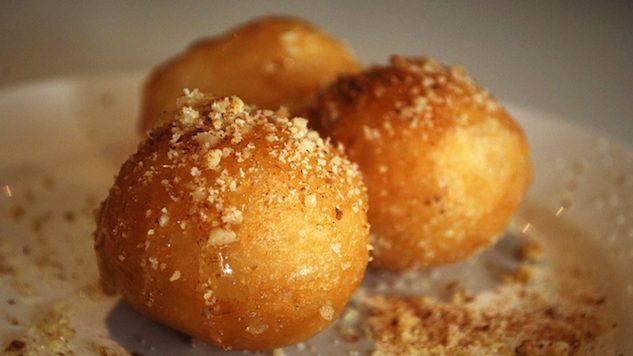
The doughnut represents an apex in human culture. We domesticated flour and yeast to make bread. We tamed fire to heat oil to frying temperatures. And we cultivated and manufactured sweetness, that ever-elusive natural flavor we crave so dearly. All of these triumphs of ingenuity combined, you’ve got one killer pastry to bring to your next meeting—and one that just about everyone in the world will recognize.
In the cultural cassoulet of the United States of America, we’ve embraced artifacts such as the zeppole, the cruller, the churro and the beignet. However, sweet balls of starchy goodness come from virtually every country on earth, and some of the most underappreciated ones can be found here with a little investigation. These 13 are worth the effort.
1. Loukoumades – Greece
Greek-American pastry shops are some of the happiest places on earth—not least of all for their embrace of local flavors—and these sweet morsels from the old country help take that joy to go. Similar to many fried sweets from the Mediterranean, loukoumades and their cousins Turkish lokma start with a yeast-risen dough and finish with hot oil and sugar. They can be rings, finger-shaped or spherical and topped with honey, sugar syrup, cinnamon and nuts.
2. Buñuelos – Latin America 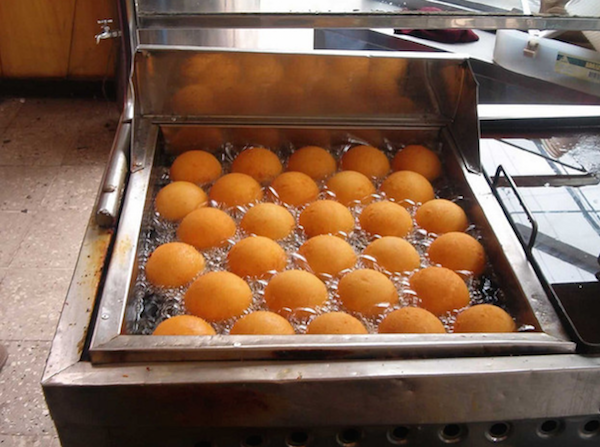 Photo by ciroduran, CC-BY
Photo by ciroduran, CC-BY
The buñuelo is a pan-Latin American confection with a history as long as its versions are varied. Generally speaking, they are fluffy, round dough balls, sometimes filled with cream or custard, sometimes glazed with piloncillo syrup, sometimes flavored with anise. By some accounts, the buñuelo came to Spain from the Sephardic Jewish community, whose fried dough bimuelos are consumed at Hanukkah—not unlike the sufganiya (jelly doughnuts) eaten in Israel and America to commemorate the miraculous oil lamps of the Maccabees. Today they are consumed in Spain for All Saints Day and are popular at Christmas in Mexico.
3. Picarones – Peru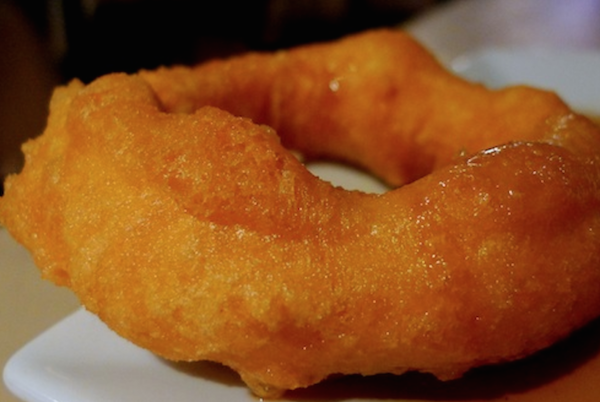 Photo by Jared Cohee
Photo by Jared Cohee
These Peruvian street food favorites have the distinction of being pastries AND vegetables. Made from a dough of pureed squash and sweet potato (among other things) they are deftly manipulated into succulent O’s by expert handlers and hopefully served hot enough to toast your fingers a little.
4. Gulab Jamun – India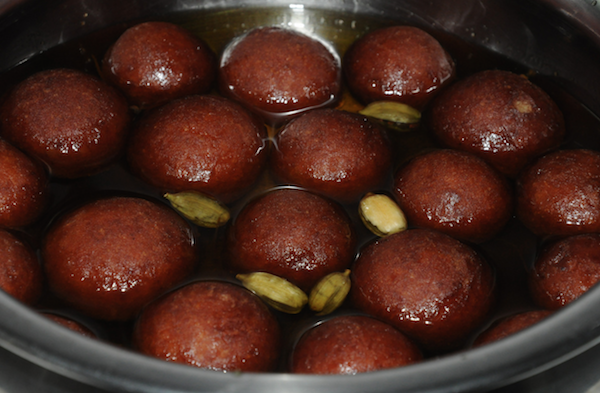 Photo by Hari Prasad Nadig, CC-BY
Photo by Hari Prasad Nadig, CC-BY
Even the most backwater Indian restaurant in the U.S. is likely to feature these delightful little dough balls at the end of the buffet table. The primary ingredient in these is not flour but milk solids, fried and then soaked in sugar syrup infused with rose, cardamom and other flavors. These are served for special occasions all over the subcontinent and in hotbeds of the South Asian diaspora like Trinidad, Suriname and Guyana.
5. Jalebi / Zalabiya- South Asia, North Africa and the Middle East 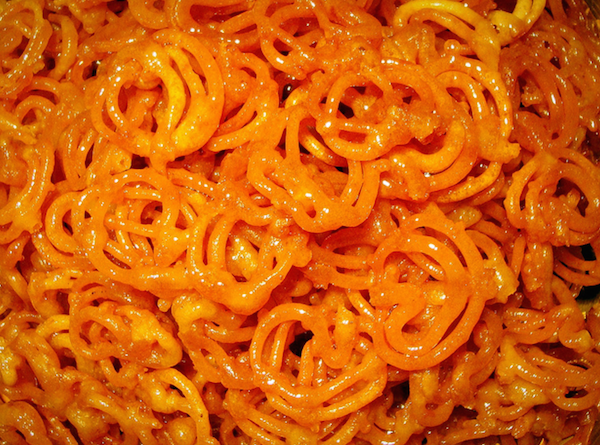 Photo by Soumyadeep Paul, CC-BY
Photo by Soumyadeep Paul, CC-BY
Like buñuelos, jalebi (aka zalabiya, zoolbiya, zulbia) are pastries beloved across entire swaths of continent. These crispy little funnel-cake-like desserts’ ingredients vary in types of flour and flavoring, changing with the local tastes as the recipe made its way from the Middle East to South Asia through conquest and trade. Batter is piped in thin strands into shapes in the frying oil, resulting in crispy, delicate swirls, fingers or pretzel shapes. Depending on where you are, you could get honey syrup, powdered sugar, cinnamon, saffron, and other flavors. A popular celebration sweet all over India and western Asia, these should be easy to find.
6. Bamieh – Iran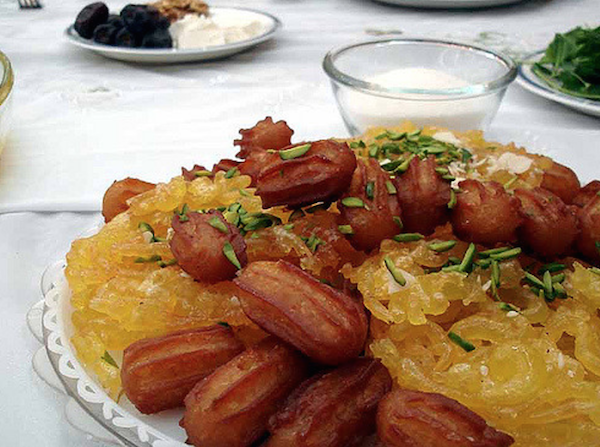 Photo by Hamed Saber, CC-BY
Photo by Hamed Saber, CC-BY
Bamieh are little finger-shaped nuggets of fried dough that rarely seem to make an appearance without their sister pastry, zoolbiya (see above), on Persian sweet plates. Chewy and dense contrasting zoolbiya’s crunch, bamieh are often covered in saffron and rose water syrup. They are the perfect size for sharing at a celebration, or for forgetting how many one has consumed with a cup of tea, just ‘cause.
7. Boortsog – Mongolia and Central Asia Photo by Alfiya Smagul, CC-BY
Photo by Alfiya Smagul, CC-BY
The Mongolian version of this fried dough snack is on the border—some call it a cookie due to its heavily kneaded, crunchy texture. This author’s take: this is America, where deep-fried sweet = doughnut. Boortsog and Kazakh baursak both start with a simple dough of flour, water, salt and shortening, that is kneaded thoroughly and deep fried in animal fat or vegetable oil. Look for these as appetizers of desserts at the Mongolian BBQ or some Indian/fusion places.
8. Jian dui/Jin deui – China Photo by sstrieu, CC-BY
Photo by sstrieu, CC-BY
Jian dui are made from glutinous rice flour, covered in sesame seeds and filled most often with black bean, lotus or red bean paste. You can find them anywhere there is a Chinese enclave—that is, everywhere in the world. Known as “sesame balls” in Chinatown bakeries, these adorable little snacks should not be mistaken for savories—they are delicious, delicious doughnuts.
9. Sopaipillas – Latin America and New Mexico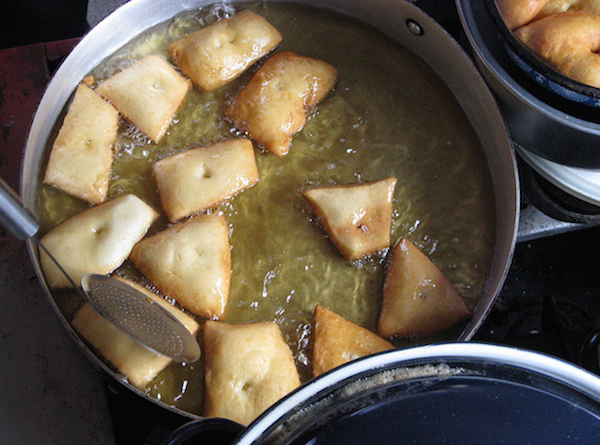 Photo by Christian Cordova, CC-BY
Photo by Christian Cordova, CC-BY
This is a tricky one. While the name originated in what is now Spain, sopaipilla refers to several distinct pastries. In Chile, Uruguay, Peru and Argentina, they are flat, fried bread rounds sometimes made with mashed squash or pumpkin, served sweetened with dark sugar syrup and spices. The other version is from the distinct culinary tradition of New Mexico; puffy pillows of fried dough drizzled with honey, served at the beginning of a meal or as dessert.
10. Ponchik – Armenia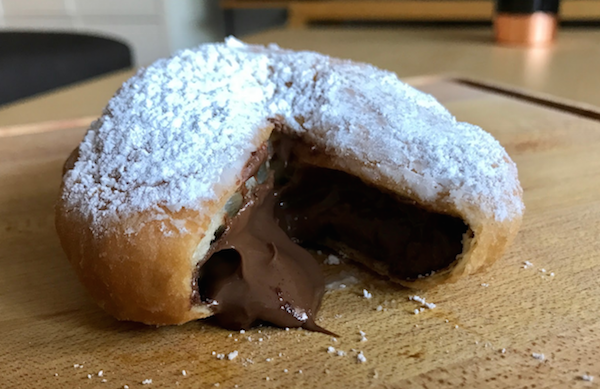 Photo by Hope Ewing
Photo by Hope Ewing
Doughnuts in Russia are also called ponchiki, but there’s something special about the Armenian-American bakery and its endless flavor options. Traditionally made with custard, made-to-order ponchiks are available at fried dough-temples like LA’s Papillon International Bakery with fruit, liquified cookie and candy filling, and Latin-influenced dulce de leche. The ruling favorite version is a relatively thin pastry shell of ricotta or farmer’s cheese, egg, and flour, injected with Nutella straight from the fryer and served hot, covered in powdered sugar.
11. Malasada – Portugal/the Azores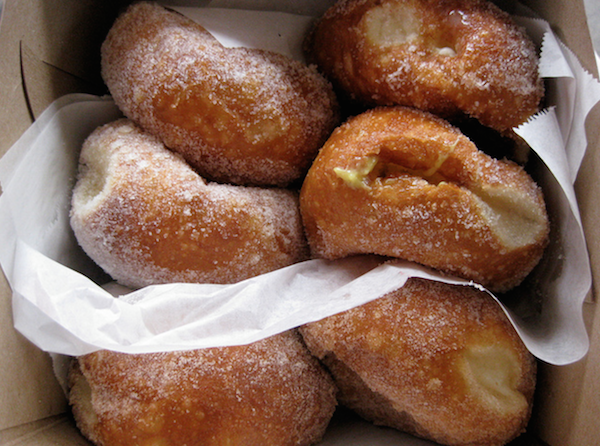 Photo by David Hwang, CC-BY
Photo by David Hwang, CC-BY
If you’ve ever visited Hawaii or Cape Cod, there’s a good chance you’ve smelled malasadas frying. It is a testament to the addictiveness of these fluffy, sugar-dusted treats that wherever there was heavy Portuguese immigration, the malasada took over the doughnut game. Traditionally round, fluffy and un-filled, purveyors such as Leonard’s Bakery in Hawaii now make them with a variety of fillings from custard to coconut pudding.
12. Berlines – Chile Photo by Constanza, CC-BY
Photo by Constanza, CC-BY
No, this is not exactly the same pastry JFK accidentally called himself in his historic Ich ben ein berliner speech. Berlines are the Chilean descendants of that German filled fried dough, the result heavy 19th and 20th century immigration from Europe. They are very straightforward doughnut fare, filled with custard or dulce de leche. Like Peruvian sushi, Chilean Berlines take the best things from two continents and combine them. Pow.
13. Sata Andagi – Okinawa Photo by Ron Dollette, CC-BY
Photo by Ron Dollette, CC-BY
The literal translation of this Japanese doughnut’s name is “deep-fried sugar.” Lest the name deceive you, these are not overly sweet compared to some of the honey-soaked items on this list. Sata andagi are simple confections made by shaping a dough of eggs, sugar, flour and salt into golf ball-sized spheres and frying them in vegetable oil, no extra dusting or syrup required. The result is dense and cakey with a crisp browned outer layer. Sprung from Okinawa’s unique regional cuisine, these guys are popular in Hawaii and other emigrant communities. Deep. Fried. Sugar.
Hope Ewing is a Los Angeles-based writer obsessed with gin, pastry, and women killing it in the bar world. Tweets found: @greatbooisup.